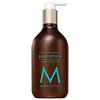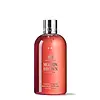What's inside
What's inside
 Key Ingredients
Key Ingredients

 Benefits
Benefits

 Concerns
Concerns

 Ingredients Side-by-side
Ingredients Side-by-side

Water
Skin ConditioningAloe Barbadensis Leaf Juice
Skin ConditioningGlycerin
HumectantDi-C12-15 Alkyl Fumarate
EmollientArgania Spinosa Kernel Oil
EmollientCaprylic/Capric Triglyceride
MaskingGlyceryl Stearate
EmollientPEG-100 Stearate
Butylene Glycol
HumectantOenothera Biennis Oil
EmollientParfum
MaskingCetyl Alcohol
EmollientPlukenetia Volubilis Seed Oil
EmollientCamellia Japonica Seed Oil
EmollientCitric Acid
BufferingTocopherol
AntioxidantCaprylyl Glycol
EmollientSodium PCA
HumectantEthylhexylglycerin
Skin ConditioningSodium Hyaluronate
HumectantHydroxyethyl Acrylate/Sodium Acryloyldimethyl Taurate Copolymer
Emulsion StabilisingXanthan Gum
EmulsifyingIsohexadecane
EmollientTocopheryl Acetate
AntioxidantDisodium EDTA
Polysorbate 60
EmulsifyingHydroxyacetophenone
AntioxidantSodium Lactate
BufferingAspartic Acid
MaskingValine
MaskingArginine
MaskingGlutamic Acid
HumectantSerine
MaskingAlanine
MaskingPhenylalanine
MaskingThreonine
Lysine Hcl
Skin ConditioningProline
Skin ConditioningIsoleucine
Skin ConditioningHistidine
HumectantSorbitan Isostearate
EmulsifyingBetaine
HumectantGlycine
BufferingPCA
HumectantSodium Benzoate
MaskingPotassium Sorbate
PreservativeChlorphenesin
AntimicrobialPhenoxyethanol
PreservativeWater, Aloe Barbadensis Leaf Juice, Glycerin, Di-C12-15 Alkyl Fumarate, Argania Spinosa Kernel Oil, Caprylic/Capric Triglyceride, Glyceryl Stearate, PEG-100 Stearate, Butylene Glycol, Oenothera Biennis Oil, Parfum, Cetyl Alcohol, Plukenetia Volubilis Seed Oil, Camellia Japonica Seed Oil, Citric Acid, Tocopherol, Caprylyl Glycol, Sodium PCA, Ethylhexylglycerin, Sodium Hyaluronate, Hydroxyethyl Acrylate/Sodium Acryloyldimethyl Taurate Copolymer, Xanthan Gum, Isohexadecane, Tocopheryl Acetate, Disodium EDTA, Polysorbate 60, Hydroxyacetophenone, Sodium Lactate, Aspartic Acid, Valine, Arginine, Glutamic Acid, Serine, Alanine, Phenylalanine, Threonine, Lysine Hcl, Proline, Isoleucine, Histidine, Sorbitan Isostearate, Betaine, Glycine, PCA, Sodium Benzoate, Potassium Sorbate, Chlorphenesin, Phenoxyethanol
Water
Skin ConditioningSodium Laureth Sulfate
CleansingCocamidopropyl Betaine
CleansingPropylene Glycol
HumectantParfum
MaskingLaureth-7 Citrate
CleansingGlycerin
HumectantSodium Chloride
MaskingCoco-Glucoside
CleansingHedychium Coronarium Flower/Leaf/Stem Extract
Skin ConditioningCalophyllum Inophyllum Seed Oil
AntimicrobialPolyquaternium-7
Lonicera Caprifolium Flower Extract
PerfumingLonicera Japonica Flower Extract
Skin ConditioningCaprylic/Capric Triglyceride
MaskingLauryl Alcohol
EmollientMyristyl Alcohol
EmollientEthylhexyl Salicylate
UV AbsorberButyl Methoxydibenzoylmethane
UV AbsorberDiethylhexyl Syringylidenemalonate
Skin ProtectingButylphenyl Methylpropional
PerfumingAlpha-Isomethyl Ionone
PerfumingHydroxyisohexyl 3-Cyclohexene Carboxaldehyde
MaskingHexyl Cinnamal
PerfumingLinalool
PerfumingEugenol
PerfumingCitronellol
PerfumingGeraniol
PerfumingTocopherol
AntioxidantTetrasodium Glutamate Diacetate
Sodium Phytate
Butylene Glycol
HumectantSorbic Acid
PreservativeBenzyl Alcohol
PerfumingSodium Benzoate
MaskingPhenoxyethanol
PreservativeCitric Acid
BufferingSodium Hydroxide
BufferingPEG-150 Pentaerythrityl Tetrastearate
EmulsifyingPPG-2 Hydroxyethyl Cocamide
EmulsifyingHydrogenated Palm Glycerides Citrate
EmollientAlcohol Denat.
AntimicrobialCI 42090
Cosmetic ColorantCI 14700
Cosmetic ColorantCI 17200
Cosmetic ColorantWater, Sodium Laureth Sulfate, Cocamidopropyl Betaine, Propylene Glycol, Parfum, Laureth-7 Citrate, Glycerin, Sodium Chloride, Coco-Glucoside, Hedychium Coronarium Flower/Leaf/Stem Extract, Calophyllum Inophyllum Seed Oil, Polyquaternium-7, Lonicera Caprifolium Flower Extract, Lonicera Japonica Flower Extract, Caprylic/Capric Triglyceride, Lauryl Alcohol, Myristyl Alcohol, Ethylhexyl Salicylate, Butyl Methoxydibenzoylmethane, Diethylhexyl Syringylidenemalonate, Butylphenyl Methylpropional, Alpha-Isomethyl Ionone, Hydroxyisohexyl 3-Cyclohexene Carboxaldehyde, Hexyl Cinnamal, Linalool, Eugenol, Citronellol, Geraniol, Tocopherol, Tetrasodium Glutamate Diacetate, Sodium Phytate, Butylene Glycol, Sorbic Acid, Benzyl Alcohol, Sodium Benzoate, Phenoxyethanol, Citric Acid, Sodium Hydroxide, PEG-150 Pentaerythrityl Tetrastearate, PPG-2 Hydroxyethyl Cocamide, Hydrogenated Palm Glycerides Citrate, Alcohol Denat., CI 42090, CI 14700, CI 17200
Ingredients Explained
These ingredients are found in both products.
Ingredients higher up in an ingredient list are typically present in a larger amount.
Butylene Glycol (or BG) is used within cosmetic products for a few different reasons:
Overall, Butylene Glycol is a safe and well-rounded ingredient that works well with other ingredients.
Though this ingredient works well with most skin types, some people with sensitive skin may experience a reaction such as allergic rashes, closed comedones, or itchiness.
Learn more about Butylene GlycolThis ingredient is an emollient, solvent, and texture enhancer. It is considered a skin-softener by helping the skin prevent moisture loss.
It helps thicken a product's formula and makes it easier to spread by dissolving clumping compounds.
Caprylic Triglyceride is made by combining glycerin with coconut oil, forming a clear liquid.
While there is an assumption Caprylic Triglyceride can clog pores due to it being derived from coconut oil, there is no research supporting this.
Learn more about Caprylic/Capric TriglycerideCitric Acid is an alpha hydroxy acid (AHA) naturally found in citrus fruits like oranges, lemons, and limes.
Like other AHAs, citric acid can exfoliate skin by breaking down the bonds that hold dead skin cells together. This helps reveal smoother and brighter skin underneath.
However, this exfoliating effect only happens at high concentrations (20%) which can be hard to find in cosmetic products.
Due to this, citric acid is usually included in small amounts as a pH adjuster. This helps keep products slightly more acidic and compatible with skin's natural pH.
In skincare formulas, citric acid can:
While it can provide some skin benefits, research shows lactic acid and glycolic acid are generally more effective and less irritating exfoliants.
Most citric acid used in skincare today is made by fermenting sugars (usually from molasses). This synthetic version is identical to the natural citrus form but easier to stabilize and use in formulations.
Read more about some other popular AHA's here:
Learn more about Citric AcidGlycerin is already naturally found in your skin. It helps moisturize and protect your skin.
A study from 2016 found glycerin to be more effective as a humectant than AHAs and hyaluronic acid.
As a humectant, it helps the skin stay hydrated by pulling moisture to your skin. The low molecular weight of glycerin allows it to pull moisture into the deeper layers of your skin.
Hydrated skin improves your skin barrier; Your skin barrier helps protect against irritants and bacteria.
Glycerin has also been found to have antimicrobial and antiviral properties. Due to these properties, glycerin is often used in wound and burn treatments.
In cosmetics, glycerin is usually derived from plants such as soybean or palm. However, it can also be sourced from animals, such as tallow or animal fat.
This ingredient is organic, colorless, odorless, and non-toxic.
Glycerin is the name for this ingredient in American English. British English uses Glycerol/Glycerine.
Learn more about GlycerinParfum is a catch-all term for an ingredient or more that is used to give a scent to products.
Also called "fragrance", this ingredient can be a blend of hundreds of chemicals or plant oils. This means every product with "fragrance" or "parfum" in the ingredients list is a different mixture.
For instance, Habanolide is a proprietary trade name for a specific aroma chemical. When used as a fragrance ingredient in cosmetics, most aroma chemicals fall under the broad labeling category of “FRAGRANCE” or “PARFUM” according to EU and US regulations.
The term 'parfum' or 'fragrance' is not regulated in many countries. In many cases, it is up to the brand to define this term.
For instance, many brands choose to label themselves as "fragrance-free" because they are not using synthetic fragrances. However, their products may still contain ingredients such as essential oils that are considered a fragrance by INCI standards.
One example is Calendula flower extract. Calendula is an essential oil that still imparts a scent or 'fragrance'.
Depending on the blend, the ingredients in the mixture can cause allergies and sensitivities on the skin. Some ingredients that are known EU allergens include linalool and citronellol.
Parfum can also be used to mask or cover an unpleasant scent.
The bottom line is: not all fragrances/parfum/ingredients are created equally. If you are worried about fragrances, we recommend taking a closer look at an ingredient. And of course, we always recommend speaking with a professional.
Learn more about ParfumPhenoxyethanol is a preservative that has germicide, antimicrobial, and aromatic properties. Studies show that phenoxyethanol can prevent microbial growth. By itself, it has a scent that is similar to that of a rose.
It's often used in formulations along with Caprylyl Glycol to preserve the shelf life of products.
Sodium Benzoate is a preservative. It's used in both cosmetic and food products to inhibit the growth of mold and bacteria. It is typically produced synthetically.
Both the US FDA and EU Health Committee have approved the use of sodium benzoate. In the US, levels of 0.1% (of the total product) are allowed.
Sodium benzoate works as a preservative by inhibiting the growth of bacteria inside of cells. It prevents the cell from fermenting a type of sugar using an enzyme called phosphofructokinase.
It is the salt of benzoic acid. Foods containing sodium benzoate include soda, salad dressings, condiments, fruit juices, wines, and snack foods.
Studies for using ascorbic acid and sodium benzoate in cosmetics are lacking, especially in skincare routines with multiple steps.
We always recommend speaking with a professional, such as a dermatologist, if you have any concerns.
Learn more about Sodium BenzoateTocopherol (also known as Vitamin E) is a common antioxidant used to help protect the skin from free-radicals and strengthen the skin barrier. It's also fat soluble - this means our skin is great at absorbing it.
Vitamin E also helps keep your natural skin lipids healthy. Your lipid skin barrier naturally consists of lipids, ceramides, and fatty acids. Vitamin E offers extra protection for your skin’s lipid barrier, keeping your skin healthy and nourished.
Another benefit is a bit of UV protection. Vitamin E helps reduce the damage caused by UVB rays. (It should not replace your sunscreen). Combining it with Vitamin C can decrease sunburned cells and hyperpigmentation after UV exposure.
You might have noticed Vitamin E + C often paired together. This is because it is great at stabilizing Vitamin C. Using the two together helps increase the effectiveness of both ingredients.
There are often claims that Vitamin E can reduce/prevent scarring, but these claims haven't been confirmed by scientific research.
Learn more about TocopherolWater. It's the most common cosmetic ingredient of all. You'll usually see it at the top of ingredient lists, meaning that it makes up the largest part of the product.
So why is it so popular? Water most often acts as a solvent - this means that it helps dissolve other ingredients into the formulation.
You'll also recognize water as that liquid we all need to stay alive. If you see this, drink a glass of water. Stay hydrated!
Learn more about Water